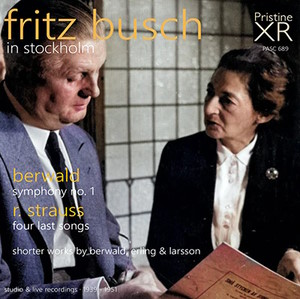
Fritz Busch (conductor)
In Stockholm
Franz Berwald (1796 – 1868)
Estrella de Soria – Overture
Symphony No. 1 “Symphonie sérieuse”
Erik Erling (1894-1966)
Intermezzo
Lars-Erik Larsson (1908-1986)
Ostinato from Symphony No. 2
Richard Strauss (1939-1951)
Four Last Songs
Sena Jurinac (soprano)
Konsertförenings Orkester, Kungliga Orkester, Stockholm Radiotjaensts Symfoniorkester
rec. live & studio, 1939-1951
Ambient Stereo XR remastering
Pristine Audio PASC689 [69]
This album finds its mark at so many levels. Here are a few: Berwald students who wish to know about conductor practice in the 1940s; Fritz Busch fans for whom Pristine has already emptied out various radio and private archives; Jurinac followers; Strauss adherents looking to discover the sound of the Four Last Songs within just few years of the completion of the cycle; followers of Swedish composers of the 19th and 20th centuries. To partake you must take the slightly roughened with the nicely smoothened. The recordings are from radio sources that are getting on for eighty years of age and to some extent bear witness to passing time. They are in mono and in two cases what we hear are parts of works.
Fritz Busch (1890-1951) led a gypsy existence, moving from orchestra to orchestra across Europe. His vapour trail can be discerned in goodly quantity from Pristine’s catalogue. This latest volume is a co-production with the Max-Reger-Institut / BuschBrothersArchive, Karlsruhe and very welcome too. Jürgen Schaarwächter, of the Institute and Archive, provides a pillar of supportive notes.
The disc begins with a bang and a spectacular splash. Busch has his wickedly invigorating way with Berwald’s Estrella de Soria Overture. Ignition, kindling and conflagration are, without ado, bundled together into flames. Estrella is not a repertoire piece, but of the few recordings I have heard this is the most exciting. Its feet are firmly planted in the Beethovenian examples: Fifth Symphony and the Egmont and Coriolan overtures. Busch seizes your attention from the off and bends you to his will. The Furies have indeed let slip the dogs of war. The whole thing boils and seethes most agreeably with horns whooping with abandon. This Estrella is an absolute gem and, allowing for historical sound, takes the high road by comparison with perfectly lively and respectable studio examples: Roy Goodman on Hyperion and Ulf Björlin on EMI. If you want to experience an exceptional Estrella then this Busch version is the one to hear.
I don’t know anything about Erik Erling but his Intermezzo (from incidental music to Värmlandssangen) is out of the same box of chocolates as Atterberg’s suite no 3. Cello and violin solos are caught in a passionately coiled embrace. It’s all as sweet as toothsome saccharine. The Ostinato from Lars-Erik Larsson’s Symphony No 2 is, it seems, often excerpted as a lollipop. It is bathed in the sepia gloom of a Gothic churchyard although the score soon finds its way to other fields of conflict. Gathering and then boiling speed propels it as if a thing in flight, in fear and in torment. The Devil take the hindmost in a Lisztian pyroclastic flow. The presence of quite a bit of audience coughing has to be borne with tolerance.
Busch’s other Berwald contribution is the Symphonie Sérieuse. At about 29 minutes the work’s four movements are taken some four minutes faster than Sixten Ehrling (Bis), about as fast as Björlin on EMI, two minutes slower than Goodman (Hyperion) and a remarkable nine minutes shorter than Kenneth Montgomery (Arte Nova) and two minutes minutes shorter than Neeme Järvi (Bis). Busch whips things along in the manner of Weber and Cherubini. The sound is less torrid and ‘distressed’ than the other earlier tracks, but a more centred studio effect is in evidence. Even so it remains a live broadcast. It’s all extremely animated, but with detail not scouted and the reading delicately detailed. This is most enjoyable and bubbles with a surprising amount of pleasing orchestrational minutiae. The troubled finale is memorable for the blurt and blart of the brass, but this feels right and is neither obtuse nor de trop.
The sound meted out to the Strauss Four Last Songs is very civilised and comparatively smooth. Set against this that the treble ‘edge’ in the other tracks is here smoothed and chamfered. Strauss and Jurinac cosy up to the listener. The sound is not as treble-stropped as the other tracks and one soon settles into the misty effect There is no want of clarity and as a historic relic the reading still cleanly delivers a juicy rich romanticism. A glowing brightness, peace attained through smooth transitions, freshly outlined woodwind and waspish energy in flight are all present and correct. In the final song Jurinac adopts a lovingly trilled and weighted account. One small demerit: on tr. 10 (the penultimate song) I became aware of a slight warble which might have been tape speed insecurity. Above and beyond such trivial things, Sena Jurinac (1921-2011), is treasurable, with a voice and liquidly lucid. There is audience applause between the songs. Jurinac can also be heard in these songs in what I believe to be an even more splendid recording on BBC Legends.
Rob Barnett
Previous review: Ralph Moore (May 2023)
Availability: Pristine Classical
Details
1. BERWALD Estrella de Soria – Overture
Konsertförenings Orkester
Stockholm, Konserthuset (broadcast live performance), 29 September 1946
2. ERLING Incidental music to Kejsarn av Portugallien – Intermezzo 7b: Värmlandssången
William Damme, violin; Carl Thelin, violoncello; members of the Kungliga Orkester
Stockholm, Church of Hedvig Eleonora, 20 November 1939
3. LARSSON Symphony No. 2 op. 17 – 3rd mvt. – Ostinato
Stockholm Radiotjaensts Symfoniorkester
Stockholm, Konserthuset (broadcast live performance), 4 December 1949
BERWALD Symphony No. 1 in G minor, ‘Symphonie sérieuse’
Konsertförenings Orkester
Stockholm, Konserthuset (broadcast live performance), 2 May 1951
R. STRAUSS Four Last Songs
Sena Jurinac, soprano; Konsertförenings Orkester
Stockholm, Konserthuset (broadcast live performance), 2 May 1951


















